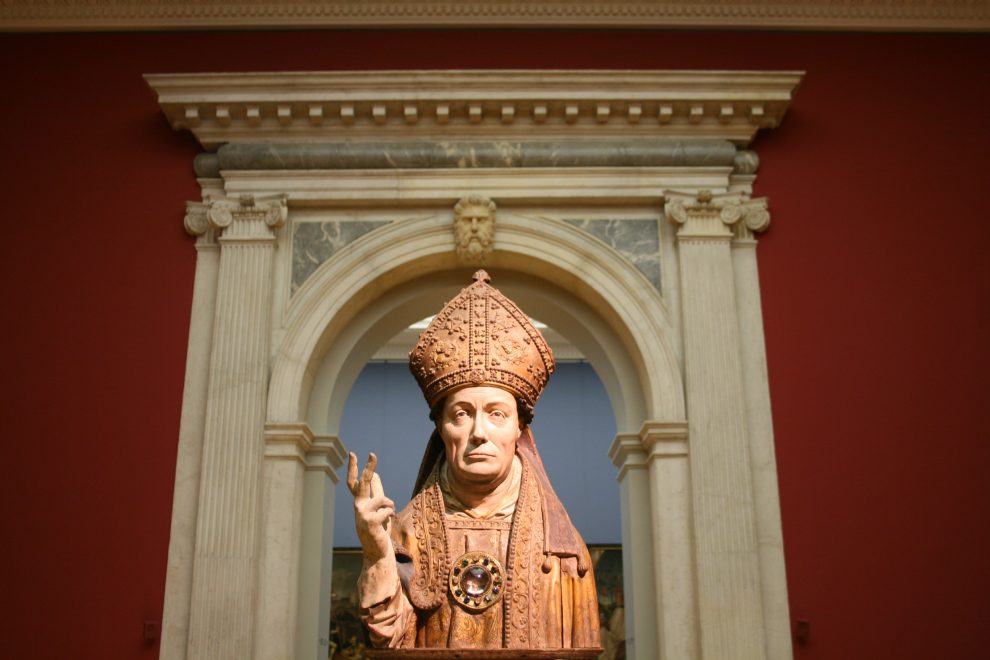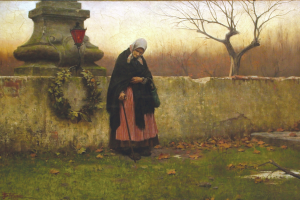With the diocesan chancery ground zero in the sex abuse crisis, now is a good time to ask whether a renovation might be in order.
“I want you to get up right now, go to your windows, open them, and stick your head out and yell, ‘I’m mad as hell and I’m not going to take it anymore!'”
That famous exclamation from the Academy Award-winning film Network (1976) was likely in the hearts–if not exactly on the lips–of several thousand Catholics from around the country who gathered at Boston College in 2002 to pray and reflect on the first wave of shocking accounts of the sexual abuse of children by some of their own long-revered Catholic priests.
Now the anger is expressed most forcefully in Ireland, Germany, and elsewhere as the scandal has gone global.
The greatest Catholic anger, however, then and since, has been focused not so much on the priest perpetrators who are clearly sick, but on bishops who enabled this behavior by recycling these clergy to new assignments and new victims, covertly paid out hush money, and deceived the Catholic faithful.
How could one understand such behavior by Catholic bishops? Why was there no honest communication from them? Were they really allowed to make these secret payoffs? Why didn’t they think about the victimized children, their parents, and the wider Catholic community? How did they get to be bishops anyhow? Why were laity excluded from decision-making?
As they sort out this list of questions, Catholic women and men reflect on their faith and their responsibility in meeting this ugly challenge. They were and are angry and hurt. Their faith, however, is still firm. “Keep the faith, but change the church!” has become their resolve in America, and church leadership should hope it goes that well elsewhere.
The U.S. bishops, meeting in Dallas in 2002, pledged zero tolerance for sexual abuse. They approved the “Charter for the Protection of Children and Young People” and a structure to follow up on the nice-sounding words. The church, they promised, would henceforth proceed with “transparency and accountability.
On the immediate issue of policing the church to avoid further sexual abuse, the American bishops deserve credit for the actions they have taken. It is important that the charter and its implementation be sustained, and I assume it will be. It could wisely be used as a model for the worldwide church. On the broader pledge to being a church proceeding with “transparency and accountability,” there is some progress, but further work is needed.
Many Catholics have the impression that the ministry of bishop is currently as it always has been throughout history, perhaps even that Jesus intended bishops to be minor monarchs. But the role of bishop can be renewed to better serve the people of God. In that spirit, I propose four ways to renovate the bishop’s office.
1. Selecting bishops
There is a broad-based chorus of voices calling for reform in the process for the selection of bishops. Papal biographer and theologian George Weigel has described the current process as “far too ingrown, with a troubled hierarchy having what seems to many an inordinate influence in shaping decisions about who will now be permitted to join the episcopal fraternity.”
He calls it “a serious mistake” that laity are not involved in any significant way in the process and notes that “laypeople can see things that clergy may miss.” Common sense suggests, says Weigel, that a more broadly consultative process would produce a more balanced assessment of the needs of a diocese and the qualifications of particular candidates.
Under the current process, the pope names diocesan bishops after a process that has the U.S. papal nuncio prepare a list of three candidates, a terna, which is submitted to the Roman Congregation for Bishops, where it is critically reviewed. The congregation then offers its own terna for the pope’s consideration. The U.S. nuncio consults, theoretically, with bishops, priests, and laity, but, as Weigel notes, the consultation process for the nunciature’s terna is “dominated by the bishops and those priests whom they trust or the nuncio trusts-which means that the process of consultation is heavily tilted toward those . . . [who] have a vested interest in the status quo.”
Ultimately, it has been not just the nuncio but a small circle of Roman officials who have controlled episcopal appointments. American church historian James O’Toole illustrates the problems of the selection process by reflecting on the career of Cardinal William O’Connell, Boston’s archbishop from 1907 to 1944. O’Toole calls the century from 1907 to now “the O’Connell century,” a period in which an expanding Vatican influence came to outweigh local interests in choosing church leaders. As O’Toole notes, it was an atmosphere in which “ambitious prelates could lobby for advancement, and their chances for success improved because they only needed to persuade a handful of Roman officials to secure the prize.”
O’Toole writes that in his five years as bishop of Portland, Maine, O’Connell “flooded Rome with evidence of his own orthodoxy and reports of the supposed theological unreliability of other claimants. He contributed financially to favored papal causes, seemingly beyond the resources of his small diocese. . . . When he got his reward in Boston, other American churchmen saw that they might pursue the same strategy.”
The real problem with O’Connell and those who practiced churchmanship in his style was less with any of these individuals than with the system that produced them, O’Toole says.
“Leaders were chosen precisely because they were disconnected from the church and city in which they were expected to be leaders,” O’Toole notes. “The Vatican clearly preferred outsiders–bishops who would feel more loyalty to Rome than to any particular diocese, place, or people. How often did newly appointed bishops say at their first press conference that they looked forward to ‘getting to know’ their city, and why did no one think that was strange?”
Rome needs to understand that it is no longer battling nobles and kings who wish to control and exploit the local church. It can safely accept a reform that respects the local church and restores the early tradition, which had the local bishop chosen by and from the people. The norm of Pope Leo I (440-461)–that no one can be a bishop unless he is elected by the clergy, accepted by his people, and consecrated by the bishops of his province–can safely and wisely be restored.
2. Collaborative leadership
Another means of renovating the bishop’s office is by implementing a more collaborative leadership structure and style. Pope John Paul II himself emphasized this when he met with a group of American bishops in 2004.
The late pope suggested that the church had historically found the resources for authentic self-renewal when it returned to its “origins in a conscious reappropriation of the apostolic tradition and a purifying re-evaluation of her institutions in light of the gospel.” He said that “in the present circumstances of the church in America, this will entail a spiritual discernment and critique of certain styles of governance, which, even in the name of a legitimate concern for good ‘administration’ and responsible oversight, can run the risk of distancing the pastor from the members of the flock, and obscuring his image as their father and brother in Christ.”
Quoting the Synod of Bishops 2003 document Pastores Gregis and its acknowledgement for the need today for each bishop to develop “a pastoral style that is ever more open to collaboration with all,” he said that a commitment to creating better structures of participation, consultation, and shared responsibility “should not be misunderstood as a concession to a secular ‘democratic’ model of governance, but as an intrinsic requirement of the exercise of episcopal authority and a necessary means of strengthening that authority.”
Unfortunately, some clergy and bishops may have learned lessons of excluding laity through their notions of what happened under the lay trustee system in early American Catholic history. Prior to 1829 Catholic churches were erected and incorporated under a lay trustee system. John Carroll, the first U.S. Catholic bishop who served as bishop of Baltimore from 1790 to 1815, saw this as the best way to secure church property and to involve the laity in the governance of the church.
Carroll faced some problems with the system, but he did not consider them major, and he never repudiated it. Later bishops voted to outlaw the trustee system in 1829. Older historical scholarship tended to focus on the relatively few bad experiences with the trustee system, to judge it negatively, and to brand it “lay trusteeism.”
More recent scholarship, such as that of Marquette University historian Patrick W. Carey, has established that the great majority of trustee experiences were characterized by “harmony and cooperation.” For example, between 1815 and 1830, considered the most volatile trustee period, churches expanded to 230 with six serious trustee disputes. In other words there were problems in only 2.6 percent of the parishes.
Nonetheless, in 1829 the bishops resolved that all future churches should be consigned to the bishop rather than trustees. Historian Gerald P. Fogarty, S.J. tersely notes: “Unfortunately, the condemnation of lay trusteeism also meant the end of an official lay voice in the church.” The “corporation sole” approach to church ownership, by which property is held exclusively in the name of the bishop, brought a certain tidiness, but also a centralization of episcopal authority that produced, as Carey notes, “a kind of episcopacy that had, as the trustees repeatedly charged, few institutional lay restraints upon episcopal powers.”
These were the circumstances that led to the radical autonomy of some bishops in the sex abuse issue. For some, the corporation sole policy became a corporation sole mentality. It was this problem that Notre Dame’s Scott Appleby addressed in 2002 in his invited remarks to the U. S. Catholic bishops regarding the sex abuse scandal: “Catholics on the right and the left and in the ‘deep middle’ are all in basic agreement as to the causes of this scandal: a betrayal of fidelity enabled by the arrogance that comes with unchecked power.”
A more democratic style of leadership and authentic collaboration will help the renovation of the bishop’s office.
3. Financial matters
A third needed renovation is through an effective system of checks and balances in financial matters. Robert McClory’s article “Collection Racket” in the May 2009 issue of this magazine addressed this issue in regard to parishes. Bishops, too, need financial checks and balances, transparency, and accountability. Historian Charles Morris found in his research that most dioceses didn’t even have financial statements until quite recently. Some of the historical fragments of financial matters that Morris reports, however, are rather disconcerting.
Dennis Dougherty, archbishop of Philadelphia from 1918 to 1951, “insisted that the cathedraticum or diocesan tax for the support of the cathedral, which ran well into six figures, was his personal income.” He also made a donation of $1 million to the Vatican when he was made a cardinal in 1921.
Many contemporary bishops have embraced the cause of fiscal accountability. As they do, one task is quite clear. The laity want publicly released annual audits at all levels. The bishops will gain credibility if they also initiate democratization of their own diocesan financial councils (DFC). Bishops need the consent of the DFC for expenditures of $1 million or more; for dioceses with fewer than 500,000, the amount is $500,000.
The DFC consists of three or more members of the Christian faithful who are appointed by the bishop. Most Catholics would regard this as a weak system of checks and balances, essentially a rubber stamp for the bishop, who can spend up to $1 million with no approval. If consent is needed for a larger expenditure, the bishop has the DFC composed exclusively of his appointees. But DFC constituted by vote of the diocesan pastoral council from a slate of qualified candidates is a reform that would help renovate the bishop’s office.
4. Protocol and lifestyle
A final renovation concerns episcopal protocol and lifestyle. James O’Toole’s description of “the O’Connell century” notes that in Boston and elsewhere “archbishops cultivated an imperial, even imperious, style of leadership.” Some were very taken with their princely status. Cardinal O’Connell caused a stir in 1911 when he insisted on being ranked ahead of the governor of Massachusetts at a formal dinner. “A governor was just a governor, after all, and [O’Connell] was a prince,” writes O’Toole.
Philadelphia’s Cardinal Dougherty in 1936 purchased an estate called the Terraces for $115,000. At the time a newly constructed home could be purchased for $5,000. The Terraces had 16 rooms, five baths, a pool, a stable, and a garage for six cars. Dougherty spent a further $100,000 building a new limestone front and a number of new rooms. Historian Charles Morris states that “none of this would be shocking if Dougherty were an oil baron, but he was a Catholic bishop, spending blue-collar donations during a national economic crisis.”
Contemporary bishops have inherited these baronial episcopal residences, but a change from the past has begun. In 2004 the Italianate cardinal’s residence that was built by Boston’s Cardinal O’Connell was sold by Cardinal Sean Patrick O’Malley. He seems to have heard the advice of laity like Richard Santagati, the president of Merrimack College, who advised O’Malley that he could “reach out to the Catholic community by choosing a lifestyle that is different from the past.”
Also in 2004 the Roman Congregation for Bishops published a lengthy Directory for the Pastoral Ministry of Bishops, which stressed the need for the bishop to exemplify holiness and all the virtues preached by Christ. It said that in reflecting Christ, each bishop should “be poor and appear to be poor,” living a modest lifestyle in keeping with the socio-economic conditions of his faithful.
New foundations
As Jesus demonstrated in the gospels when he drove the money-changers from the temple, anger is not necessarily a bad thing. The episode is important and is recorded in each of the four gospels. Not unlike the famous exclamation from Network, Jesus was not going to take it anymore from those who desecrated his Father’s house. Many laity and clergy and bishops, too, have shared that kind of anger with the sex abuse scandal.
We now have an opportunity to move from anger toward constructive change that can help renew the church. The renovations I have proposed in the bishop’s office involve some changes for the whole community. Let us keep the faith as we together undertake these and all our needed renovations, both institutional and personal.
This article appeared in the July 2010 issue of U.S. Catholic (Vol. 75, No. 7, pages 33-36). Portions of this essay previously appeared in Theology Today (January 2009).
Image: judit agusti aranda from Pexels















Add comment